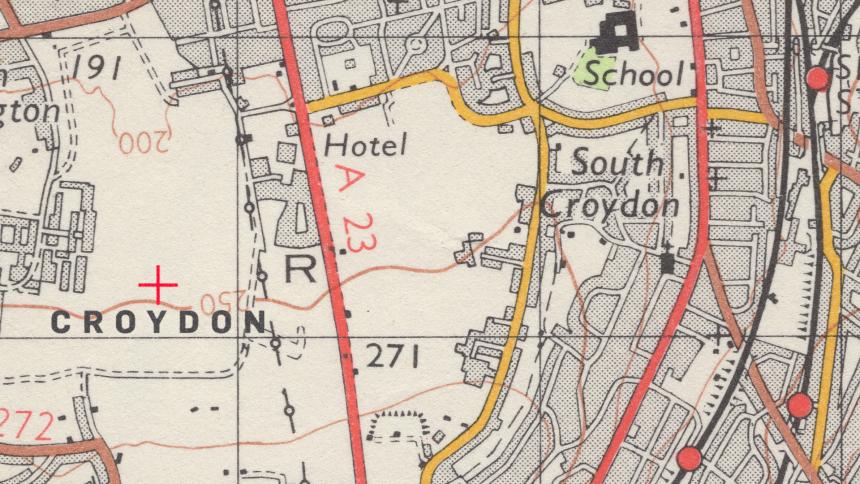
Croydon: crime profile
Murdertown, the fascinating true-crime series which takes a detailed look at how detectives and reporters dealt with vicious crimes in towns and cities across the UK, comes to an end in Croydon.
Here, host Katherine Kelly looks at the crimes of Mario Celaire, a professional footballer who was implicated in the murder of an ex-girlfriend in 2002. It’s a story of rage and ruthless violence, and of a crucial change in British law which allowed detectives to close in on the seemingly untouchable Celaire.
But what of the other homicides which stunned Croydon’s community? One of the worst involved a budding model who’d been tipped for great things, but whose life was extinguished in the cruellest way imaginable.
Sally Anne Bowman was a girl with the world at her feet. The tall, blonde model had enrolled at Croydon’s famed BRIT School, the talent incubator for the likes of Adele and Amy Winehouse, and in 2005 she was being spoken of in the same breath as Kate Moss.
But that same year, everything came to a tragic and premature end for the 18-year-old after a normal night out in Croydon with friends. Trying to get back home in the early hours, she called an ex-boyfriend, Lewis Sproston, who dutifully picked her up and drove her to her street. An argument broke out, with the exes rowing over infidelity in their relationship.
I am totally disgusted with myself...
Moments after he dropped her off right outside her door, Sally Anne Bowman was stabbed and raped and left to bleed to death. Unsurprisingly, given he was the last to see her and given their volatile relationship, Sproston was the prime suspect.
Luckily for the hapless ex-boyfriend, genetic material found on her body eventually ruled him out. However, the DNA had no match on the database, and detectives were at a dead end. Then, months later, a man was arrested after a pub brawl while watching an England football game. He had a DNA swab taken as a matter of course, and that swab was flagged up as a match with the Bowman case. The man was a 37-year-old chef named Mark Dixie. Cornered by the evidence against him, Dixie came up with a desperate and ghoulish story. He claimed he’d come across Sally Anne after she’d already been stabbed, and had sex with her dying body. ‘I am totally disgusted with myself,’ he told the court, unconvincingly.
It also turned out that Dixie had an extensive criminal record, with convictions for robbery and indecent assaults. Indeed, in 2017 Dixie – already serving his sentence for Bowman’s murder – was given further life sentences for two more sex attacks in his past.
The crucial role DNA played in his apprehension, and the unnerving fact that he may well have escaped justice if the swab hadn’t been taken for a minor pub brawl months after the murder, led to renewed media discussion about whether a national DNA register should be set up in Britain.
Few murders are as horrifying as those perpetrated by trusted family members. In 2012, when 12-year-old Tia Sharp disappeared after apparently leaving her grandmother’s house to go shopping in Croydon, focus very quickly turned to her grandmother’s boyfriend, 37-year-old Stuart Hazell. Hazell was even asked in a TV interview about how he felt about suspicion falling on him. He was adamant that he’d told the truth, and that Tia had simply walked out of the house and vanished. But, shortly after that, her body was discovered in the attic of that same house.
Incredibly, it had taken three police searches to find the corpse, which had been wrapped up in plastic and was badly decomposing. Not only did a specialist team fail to find the body, but when a search dog seemed to sniff something amiss, the clue wasn’t followed up because the dog was too big to be carried into the attic.
But, having found the body at last, police were able to piece together what had happened. Memory cards hidden by Hazell were found, containing voyeuristic ‘creep shots’ he’d taken of Tia sleeping and rubbing skin cream on her legs, as well as photos of her corpse in sexual positions.
The dilemma facing the judge was whether to impose a whole-life order on Hazell. He decided he could not, as – while Hazell was clearly sexually obsessed with the young girl – the murder itself could not be proven to have been sexually motivated, and may have resulted from ‘shame and fear of what might happen if Tia talked’.
Hazell was instead given a life sentence with a minimum term of 38 years, bringing the dreadful case to an end.
One of the greatest mysteries in the history of Croydon unfolded in the late 1920s, when three members of the same Croydon family died in suspicious circumstances. The first death was that of Edmund Duff, a 59-year-old who’d returned home after a fishing trip in April 1928 and fallen violently ill after dinner. He died shortly afterwards, after hours of painful stomach cramps.
Almost a year later, his sister-in-law, Vera Sidney, began suffering nausea and cramps after eating lunch, dying days later. A doctor explained it away as ‘gastric influenza’. But, one month after her demise, it was the turn of her mother, Violet, who also succumbed to pains and died after a lunch.
An inquest into the bizarre array of deaths found that arsenic had been involved in the deaths of all three victims, but nobody was brought to justice. It has been speculated that the culprit was Grace, the much younger wife of first victim Edmund. Rumour had it she was having an affair with the family doctor, which gave her a good motive for wanting Edmund out of the way. According to this theory, she then picked off her own sister and mother for financial gain.
A competing theory is that no murders were committed at all, and that Edmund and Vera had died of natural causes, and a grief-stricken Violet had then killed herself after the twin tragedies. As for the arsenic in their bodies – this may have been absorbed from environmental sources, in the days when toxins were more widespread.
The truth will never be known. Interestingly, the Croydon ‘poisonings’ were of particular fascination to none other than Agatha Christie, whose novel Ordeal by Innocence was partly inspired by the case.
Murdertown season 2, returns Monday 16th September at 9pm.







